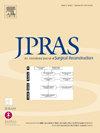有面部透明质酸注射史的晚期眶周水肿患者:诊断和处理综述
IF 2
3区 医学
Q2 SURGERY
Journal of Plastic Reconstructive and Aesthetic Surgery
Pub Date : 2024-09-20
DOI:10.1016/j.bjps.2024.09.061
引用次数: 0
摘要
背景透明质酸(HA)注射用于软组织增量,尤其是面部软组织增量,已变得越来越流行。然而,越来越多的报告显示这种手术存在并发症,这给医生带来了挑战。方法通过文献检索,找到描述 HA 注射后睑板水肿和眼睑水肿的文章。结果HA注射后眼眶周围水肿的发病率各不相同,延迟发病发生在数周至数年后。表现为眼睑和颊部弥漫性水肿,有时因感染等诱发因素而加重。病理生理学讨论区分了炎症和非炎症原因,强调了淋巴和静脉流动障碍。风险因素包括填充物特性、注射深度和患者体质。使用超声波检查对患者进行适当的评估有助于制定治疗计划,其中可能涉及皮质类固醇、用于去除HA的透明质酸酶以及后续的美容程序,如射频(RF)微针。HA溶解后应考虑手术干预,尤其是需要进行下眼睑整形手术的病例。结论面部HA注射后的晚期眶周水肿曾经很少见,但现在却经常出现。在临床实践中,了解并解决这一并发症对于优化患者护理和治疗效果至关重要。治疗方法通常包括调整透明质酸酶的剂量以去除 HA。眼睑成形术、射频针刺或填充物再注射等附加程序可改善治疗后的外观。本文章由计算机程序翻译,如有差异,请以英文原文为准。
Late-onset periorbital edema in patients with a history of facial hyaluronic acid injection: A review on diagnosis and management
Background
Hyaluronic acid (HA) injections for soft tissue augmentation, particularly in the facial area, have become increasingly popular. Nevertheless, a growing number of reports indicate complications associated with this procedure, posing challenges for practitioners. One commonly encountered complication is periorbital edema.
Objective
To review the existing literature on late-onset periorbital edema following HA injections, focusing on clinical presentation, proposed mechanisms, risk factors, diagnostics, and management strategies.
Methods
A literature search was conducted to find articles describing findings on malar edema and eyelid edema following HA injections. The gathered data were categorized and juxtaposed to provide a clearer understanding of this phenomenon.
Results
Incidence rates of periorbital edema post-HA injection vary, with delayed onset occurring weeks to years later. The manifestation involves diffuse edema in the eyelids and malar area, sometimes worsened by trigger factors like infections. Pathophysiology discussions distinguish between inflammatory and non-inflammatory causes, highlighting lymphatic and venous flow disturbances. Risk factors include filler characteristics, injection depth, and patient predispositions. Proper patient evaluation using ultrasonography aids in treatment planning, which could involve corticosteroids, hyaluronidase for HA removal, and subsequent cosmetic procedures like radiofrequency (RF) microneedling. Surgical interventions should be considered after HA dissolution, especially in cases requiring lower blepharoplasty.
Conclusion
Late periorbital edema post-facial HA injections, once rare, is now frequently seen. Understanding and addressing this complication is essential for optimizing patient care and outcomes in clinical practice. Treatment typically involves adjusting hyaluronidase dosage for HA removal. Additional procedures like blepharoplasty, RF needling, or filler reinjection may enhance post-treatment appearance.
求助全文
通过发布文献求助,成功后即可免费获取论文全文。
去求助
来源期刊
CiteScore
3.10
自引率
11.10%
发文量
578
审稿时长
3.5 months
期刊介绍:
JPRAS An International Journal of Surgical Reconstruction is one of the world''s leading international journals, covering all the reconstructive and aesthetic aspects of plastic surgery.
The journal presents the latest surgical procedures with audit and outcome studies of new and established techniques in plastic surgery including: cleft lip and palate and other heads and neck surgery, hand surgery, lower limb trauma, burns, skin cancer, breast surgery and aesthetic surgery.

 求助内容:
求助内容: 应助结果提醒方式:
应助结果提醒方式:


